GLBenchmark 2.5 Performance on Modern Android Smartphones & Tablets
by Anand Lal Shimpi & Brian Klug on July 31, 2012 10:00 AM EST- Posted in
- Smartphones
- GLBenchmark
- Mobile
- Tablets
- SoCs
Smartphones
There's a bit more variety in our smartphone GLBenchmark 2.5 results. Here we have two Samsung SoCs paired with the ARM Mali-400 MP4 GPU: the original dual-core Exynos 4210 as well as the Exynos 4 Quad (4412) from the international Galaxy S 3. Tegra 3 makes an appearance, as does TI's OMAP 4460. The latter shows up in two configurations, one with the SGX 540 running at full 384MHz clocks in the Huawei Ascend P1 and another with the SGX 540 running at 307MHz in the Galaxy Nexus (CPU clocks are 20% lower as well in the GN). Finally we have Qualcomm's dual-core Snapdragon S4 with its Adreno 225 GPU in the HTC One X and the US Galaxy S 3.
The Mali-400/MP4 continues to be the fill rate king, outpacing NVIDIA's Tegra 3 by over 50%. The advantage doesn't extend however to the triangle tests, expressing a key weakness in the Mali-400/MP4 architecture: significantly ratchet up polygon counts and performance falls flat. Remember that Mali-400 isn't a unified shader architecture, and explicitly features more pixel shader hardware than vertex shader hardware. Qualcomm inches ahead in the vertex and fragment lit triangle throughput tests, although NVIDIA remains quite competitive. Both the Mali-400 and SGX 540 don't do well here.
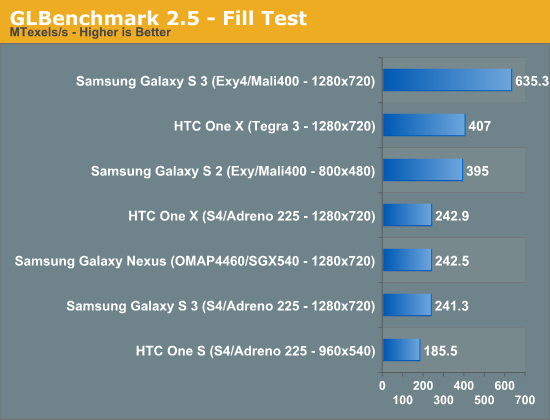
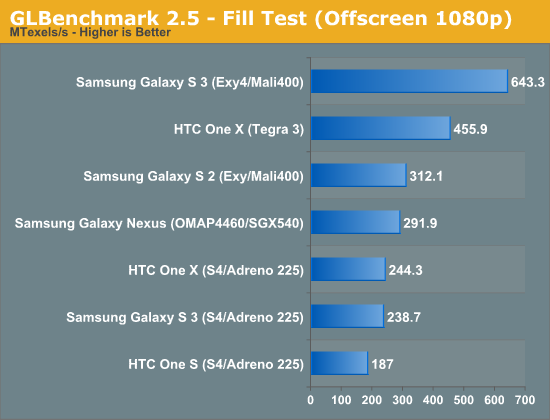
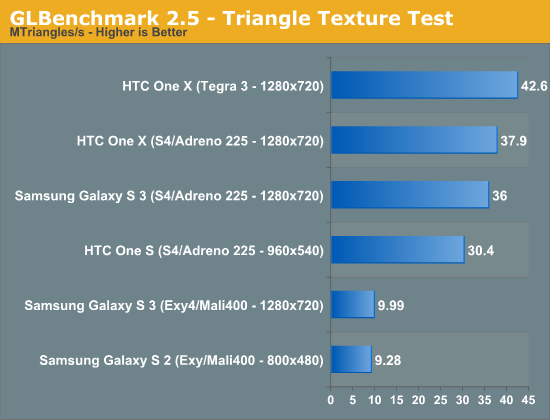
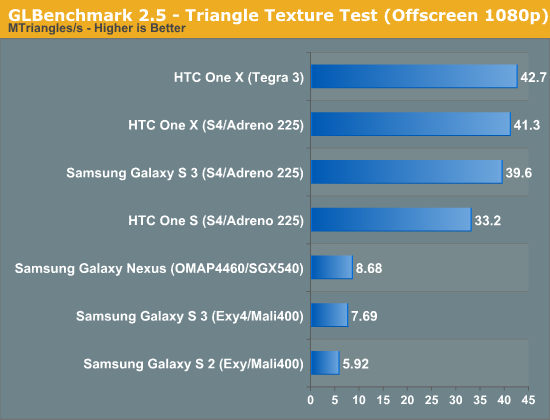
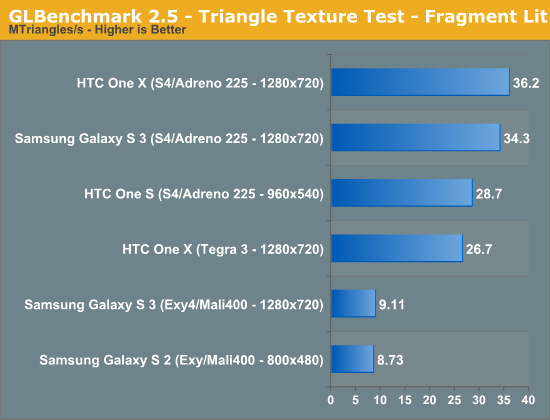
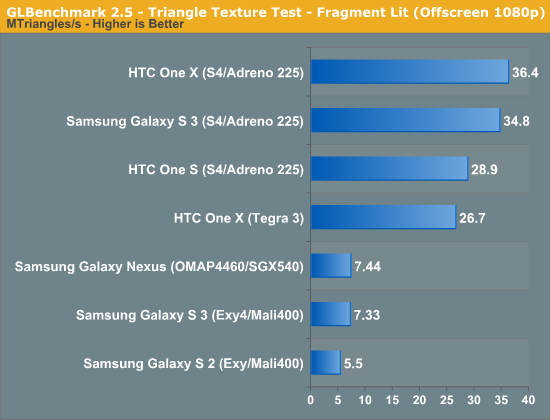
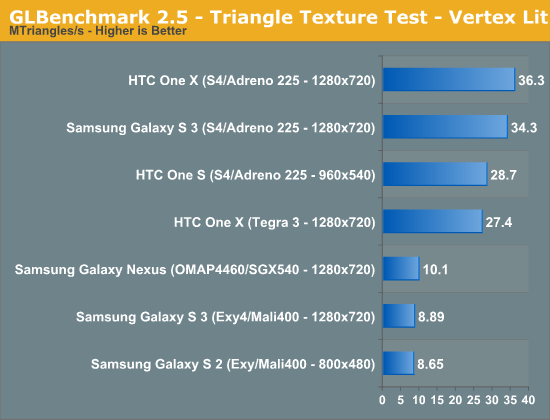

Egypt HD doesn't look quite as bad in the smartphone results, but that's mostly because we have some resolutions at 960 x 540 or below. Even then, none of these devices can break 30 fps. Remove vsync and crank up the resolution to 1080p and we hit the same ~13 fps cap as we did on the tablets.


The classic results once again show us that for lighter workloads, all of the modern GPUs (Mali 400, Adreno 225, Tegra 3) are sufficient. At lower polygon counts, even the latest Mali 400 can hit nearly 60 fps at 1080p.
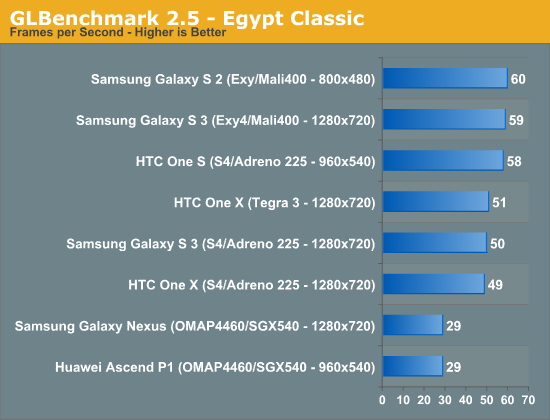
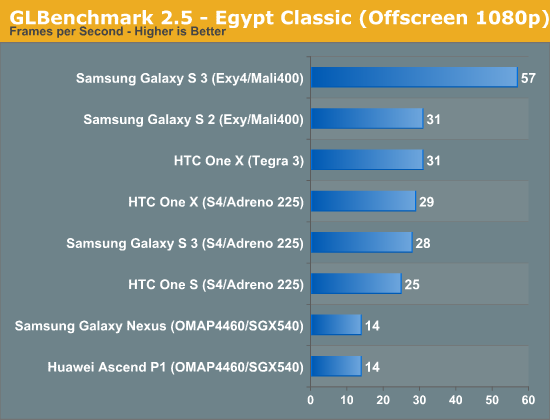










47 Comments
View All Comments
tipoo - Tuesday, July 31, 2012 - link
I wonder where these would be ranked among old desktop GPUs, Geforce 4 series-ish? FX series?aruisdante - Tuesday, July 31, 2012 - link
They're much more modern than that in terms of features, as they support the roughly mobile equivalent to DX9/OpenGL2.0.The fact that Tegra and Mali have dedicated Pixel and Vertex shades puts them in roughly the GeForce 7 series, although they're probably more powerful clock-per-clock-per-unit than those cores were (not enough to make up the vast difference in clock-speed though). If you just look at raw hardware, it would put them roughly equivalent to somewhere between a 7300GT and a 7600GT. However their raw throughput numbers are a lot lower thanks to the reduced clockspeeds- Even a 7100GS ran at 600+Mhz.
The SGX is a Unified Shader Arch supporting DX10.1 like functionality, putting it in the GeForce8-GTX200 era. What they define as a 'core' is a bit hard to figure out (I would guess they mean SMP, I.E. a cluster of smaller USA Shader Units), but based on the numbers it would be somewhere at the very bottom of the rung, like GeForce 9300 but not even.
tipoo - Tuesday, July 31, 2012 - link
Funny how much more advanced SGX GPUs are than a GPU giant like Nvidias. But that could well change next gen with kepler based Tegras.tuxRoller - Tuesday, July 31, 2012 - link
I believe adreno is also unified since the 200 series.I'd also be astonished if nivida gets anywhere close to the 3.5 years old 543mp let alone any of their newer models. I imagine the problem for nvidia will be getting around all the patents of img.
GraveUypo - Tuesday, September 25, 2012 - link
i know i'm a few months late to the party but...he was almost spot-on as far as raw performance goes on his guess. i'll be honest, i'm not familiar with the performance of the lower end nvidia cards, but a 7600GT is definitively a lot faster than even the ipad 3 gpu.
features aside, if we stick to theoretical peak performance, most current mobile gpus rank in between a geforce 4 ti4600 and a geforce fx. here's a quick comparison of gpu theoretical peak performance:
· Nexus 7 (tegra 3) - 10 Gflops
· Galaxy s3 (mali-400mp) - 15,8 Gflops
· IPad 3 (SGX 543MP4) - 25,6 Gflops
· Geforce 4 Ti4600 - 16 Gflops
· Geforce FX 5950 Ultra - 30,4 Gflops
· Geforce 6800 Ultra - 75 Gflops
· > Geforce 7600 GT - 136 Gflops
· xbox360 and ps3 gpu - somewhere around here, closer to the latter
· Geforce 7950 GT - 255 Gflops
as you can see, there's still a lot of ground to cover to get to 7600GT levels of performance. maybe in a couple more generations. This is a very simplified comparison, because there's no way to compare them directly, but it's enough to give you an idea of the situation.
GraveUypo - Tuesday, September 25, 2012 - link
(a few months later, but here we go)yes. very nice guess.
in fact the theoretical peak performance of the mali-400mp on the galaxy s3 is virtually the same as a geforce4 ti4600. the SGX 543MP4 on the ipad 3 is a bit inferior to the geforce fx 5900 ultra. read my other post for more details :P
UpSpin - Tuesday, July 31, 2012 - link
So Tegra 3 is better and Exynos Quadcore worse than most people think. At least in more demanding games with more polygons.And thus the US Galaxy S3 probably faster in more recent games with more polygons than the international quad core version. (more modern ARM core and faster GPU).
It will be interesting how well the Apple SoCs scale with this HD test.
And even if the results might look poor, but including some older speced SoCs might be interesting, too, to see how the new SoCs improved. Like some older Snapdragons. (and only Offscreen seems to be interesting)
Arnulf - Tuesday, July 31, 2012 - link
WTF are you babbling about, there is no mention of Exynos, let alone quad core Exynos, anywhere in the article. ?!owan - Tuesday, July 31, 2012 - link
Did you even read the second page?owned66 - Tuesday, July 31, 2012 - link
lol epic fail